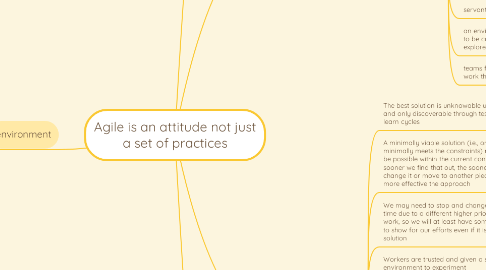
1. It means you are continuously looking for more effective ways to:
1.1. discover, understand & deliver value early and often
1.1.1. learn and adapt to VUCA
1.1.1.1. adapt plan according to new insights gleaned from feedback and experiences
1.1.1.2. keep building the simplest possible increment of business/customer value in a continuous test and learn cycle
1.1.1.2.1. simplicity-the art of maximising the amount of work not done
1.1.1.2.2. simplest possible thing that will work
1.1.1.2.3. walking skeleton
1.1.1.3. a clear definition of what progress and setbacks mean and the visibility of it to all stakeholders
1.1.2. seek root causes/insights
1.1.2.1. experimental, test-and-learn approach to discovery
1.1.2.2. collaboratively working with customers and co-creating solutions with them
1.1.2.2.1. not order-taking
1.1.2.2.2. nor over-engineering/gold-plating
1.1.2.3. keep options open as long as possible
1.1.2.3.1. prefer options to commitments
1.1.3. apply an economic framework to the understanding of value (and prioritisation)
1.2. inspire, align and support people
1.2.1. understand the capabilities, goals and ambitions of individuals and align them to the long-term mission of the team, business units & enterprise
1.2.1.1. autonomy
1.2.1.2. purpose
1.2.1.3. mastery
1.2.2. ensure work is performed at a sustainable pace
1.2.3. ensure people and teams have the right capabilities, systems, tools, environment and level of trust to thrive
1.2.3.1. minimal distractions and interruptions
1.3. reflect, learn and improve
1.3.1. form a big picture, end-to-end and long view of delivery
1.3.1.1. ensure there is transparency of progress and obstacles
1.3.1.2. lots of planning
1.3.1.3. building of quality in
1.3.2. ensure there is actionable metrics to support decision making
1.3.3. seek to reduce bureaucracy and other waste (Lean) in general
1.3.3.1. not committing to work before everyone is confident that it will flow to completion without delay
1.3.3.2. understanding team capacity and making sure teams are comfortable with their commitments
1.3.3.3. reducing hand-offs, and making the pipeline of work visible to all
1.3.3.4. identify queues and bottlenecks
2. It works best when you have:
2.1. clear direction and focus
2.2. the right skills and experience
2.2.1. access to as rich and diverse a group of experts and customers as possible
2.3. teams that are:
2.3.1. small
2.3.2. stable
2.3.3. dedicated
2.3.4. long-lived
2.3.5. trusted to get job done
2.3.6. given authority to:
2.3.6.1. decide
2.3.6.2. self-organise
2.3.6.3. share ownership and hold each other accountable
2.3.7. cross-functional
2.3.8. close knit
2.3.8.1. osmotic communication
2.4. servant leaders
2.5. an environment that encourages people to be curious and made safe for them to explore, experiment & make mistakes
2.6. teams funded independently from the work they do
3. It assumes
3.1. The best solution is unknowable upfront and only discoverable through test and learn cycles
3.2. A minimally viable solution (i.e., one that minimally meets the constraints) may not even be possible within the current constraints, so the sooner we find that out, the sooner we can change it or move to another piece of work the more effective the approach
3.3. We may need to stop and change focus at any time due to a different higher priority piece of work, so we will at least have something to deliver to show for our efforts even if it is only a minimal solution
3.4. Workers are trusted and given a safe environment to experiment
3.5. Planning is very important, but plans are going to be wrong so we better learn to adapt them rapidly
3.6. Authority to make decisions is aligned to peoples responsibilities
3.7. Authority is given where information, competence and clarity lie (tends to be decentralised)
3.8. There are often risks that if not addressed/discovered could cause the initiative to fail, so better expose them asap
3.9. It's difficult to assess the value of proposed product/service capabilities over time; this risk needs to be actively mitigated during each capability's backlog lifetime (not just set once at the beginning)
3.10. Not all capabilities are equal and all capabilities should be perceived as a liability unless proven otherwise!
3.11. There is always something to improve and that we will never reach a state of perfection
4. Principles
4.1. Pull versus Push
4.1.1. bring the work to the squad, don't send the people to the work
4.2. Transparency
4.2.1. make progress & setbacks visible
4.2.2. catch problems when they are still small
4.3. Servant leadership / Self-organising
4.3.1. a man convinced against his will is of the same opinion still
4.3.2. move people from "I have to" towards "I want to"
4.4. Continuous learning & improvement
4.4.1. safe to fail experiments
4.4.1.1. no fear culture
4.4.2. experimentation over elaborate planning
4.5. Customer Focus
4.5.1. cocreation over service provider
4.5.2. customer feedback over team intuition
4.5.3. people will tell you what they want when you have given them what they asked for
4.5.4. Nothing is more expensive than a feature that is not delivering any value
4.6. Shared ownership
4.6.1. we keep our iteration commitments
4.6.2. an iteration has one or two big ticket goals no more
4.6.3. the squad makes sure they achieve those ones
4.7. Continuous delivery
4.7.1. effectiveness over efficiency
4.7.2. tight feedback loops aren't necessarily efficient but they are usually effective
4.7.3. reduce the cost of iterating
4.8. Collaboration
4.8.1. 'all for one, one for all'
4.8.2. the squad as a whole owns the iteration work
4.8.3. the squad that builds something maintains it too
4.8.3.1. no throwing over the wall to a support squad
4.9. Focus
4.9.1. don't bring the whirlwind into the iteration
4.9.1.1. whirlwind = the daily tasks that need to be done
4.9.2. stop starting, start finishing
4.10. Technical Excellence
4.10.1. availability isn't a skill
4.10.2. delivery as a craft rather than a factory line
4.10.3. T-shaping is an expectation not a nice-to-have
